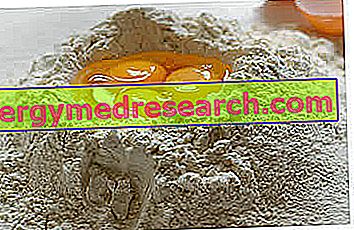Generality
Egg pasta is a basic preparation of Italian cuisine, especially in the Emilia area. It is a simple dough, based on hen's eggs and wheat flour, divided into small regular shapes and intended for cooking with moist heat.

WARNING! It is not uncommon for egg pasta to be mistakenly called "puff pastry". The misunderstanding arises from the fact that the fresh pasta spread (later we will see how) acquires the name of sfoia, or sfoglia (from foi or sheet); in reality, the puff pastry itself is a TOTALLY different preparation, French, rich in butter, basically devoid of eggs and destined for sweet and savory pastry.
Nutritional Features
From egg pasta we obtain first starchy dishes rich in gluten. The caloric prevalence of egg pasta is therefore attributable to the content in complex carbohydrates. Proteins follow, more important than semolina pasta; finally fatty acids. The fiber is present in a medium quantity but slightly higher than the semolina one. Unlike the latter, the egg (both fresh and dry) also provides a certain amount of cholesterol.
The energy intake of dry egg pasta is similar (slightly higher) to that of dry semolina pasta. That of fresh egg pasta, on the other hand, is more similar to the energy produced by COTTA semolina pasta. Being already highly hydrated, during cooking, fresh egg pasta DOES NOT show significant volume growth.
As far as mineral salts are concerned, egg pasta stands out for the greater presence of iron; on the contrary, with regard to vitamins, retinol equivalents or vit are well present. A. (thanks to the egg carotenoids).
Variations of Egg Pasta
Obviously, egg pasta can be made using ingredients of the same kind but different from the traditional ones. For example, they can change the types of eggs or the yolk / egg white ratio: guinea fowl, duck, goose, turkey eggs, more yolk than albumen, more egg white than yolk, etc.
It is also possible to change the type of flour used: whole wheat flour, type 1, type 0, durum wheat semolina, etc. Egg pasta can also be made in different colors: red (with the use of tomato paste or red beetroot puree), green (with the addition of cooked, squeezed and finely chopped herbs), black with black of sepia etc.
To flavor egg pasta just add the desired spice; some types are: saffron, chilli, paprika, pepper, mustard, turmeric, etc.
Traditional Egg Pasta Color
For a traditional FRESH egg pasta it is crucial that the eggs are fresh, with an intense orange, almost red, yolk. Many readers will wonder how it is possible to understand the color of the yolk before having broken it. There is not! Once upon a time, when egg pasta was a customary preparation in the peasant homes of the Po valley, the zdore (or azdore ) knew that to make egg pasta it was necessary to feed laying hens with food (kitchen scraps and grains) Red. It will seem strange, but it works! In fact, the pigment of the egg yolk is due to the presence of pro-vitamin A of the carotenoid type; it goes without saying that the higher the nutritional content in carotenoids of the hen, the better the pigmentation of the egg is. In addition to rotten peppers, broken carrots, tomato peels (residues from the preparation of the preserves), melon peel and watermelon etc., it is advisable to feed the laying hens with a portion of corn from popcorn.
Other Egg Doughs
While tradition teaches above all to "manipulate" egg pasta, the innovative kitchen suggests how to optimize the dough based on the recipe. Be clear, from a good egg pasta you can get all the possible dishes that need this base; on the other hand, some technicians have developed some slightly different recipes that lend themselves specifically to some products.
I take this opportunity to report what was described by Michele D'Agostino (cook of the Italian Chefs Federation) in a file produced by consulting the archive of the University of Italian Cuisine and published on the website www.assocuochibaresi.it.
Recipe of basic fresh egg pasta
Ingredients: "00" type soft wheat flour 800g, 200g durum wheat semolina and 10th chicken eggs. Some also add a tablespoon of extra virgin olive oil but it is not part of the Emilian tradition.
Recipe of fresh egg pasta for ravioli
Ingredients: "00" type wheat flour 800g, 200g durum wheat semolina and 10th chicken eggs, one tablespoon of extra virgin olive oil and one of white wine vinegar.
Recipe of fresh egg pasta for angel hair
Ingredients: "0" type soft wheat flour 1000g, egg yolks 900g.
Recipe of fresh egg pasta for spaghetti with wine press
Ingredients: "00" type soft wheat flour 500g, 500g durum wheat semolina and 350g chicken eggs.
Recipe of fresh egg pasta with pepper
Ingredients: "0" type soft wheat flour 1000g, 80g egg yolk, whole eggs 200g and pasteurized pepper 100g.
Recipe of fresh egg pasta with cuttlefish ink
Ingredients: soft wheat flour type "00" 1000g, egg yolk 100g, whole eggs 250g and cuttlefish ink 50g.
Recipe of fresh green egg pasta
Ingredients: wheat flour type "00" 1000g, chicken eggs 200g, chlorophyll 100g and a tablespoon of extra virgin olive oil.
Recipe of red fresh egg pasta
Ingredients: soft wheat flour type "00" 500g, durum wheat semolina 60g, egg yolk 100g, whole egg n ° 1, 200g puree red beets and a tablespoon of extra virgin olive oil.
Saffron egg pasta recipe
Ingredients: "00" type soft wheat flour 800g, 200g durum wheat semolina, whole 400g hen eggs, 4 diluted saffron sachets.
Truffle egg pasta recipe
Ingredients: soft wheat flour type "00" 1000g, whole eggs 350g, truffle puree 10g, truffle oil 1 tbsp, water QB.
Egg Pasta Process
The procedure for preparing FRESCA egg pasta is simple, but it is not easy! In practice, the various processing steps are rather clear but their correct execution is not something for everyone.
The necessary tools are: pastry board, fork or small whisk and scraper.
Begin by forming a fountain (like a "volcano") with flour. Inside, the eggs are broken, then beaten with a fork or whisk. At this point, always with the fork or whisk, the flour is gradually incorporated from the edges of the fountain until the consistency of the central dough is so high as to make it impossible to continue. Now, put away your fork or whisk and start using your hands; first the whole flour is incorporated by mixing the dough (still raw), then, with "elbow grease" and using the scraper, it is kneaded, taking care NOT to leave pieces of dough attached to the pastry board or on the hands. We continue to manipulate the egg pasta to obtain a smooth and uniform mixture; finally, put it in the fridge to rest for at least 30 '.
NB : The mixture of flour (soft wheat and durum wheat) determines the hardness and consistency of the dough. The more durum wheat is used, the greater the strength (physical and heat) and the difficulty of mixing.
Dry egg pasta is a prerogative of industrial processing; in this case, in addition to the use of freeze-dried and rehydrated eggs, the method of dehydration with cold air is applied.
Fresh homemade pasta - yellow pasta, green pasta and black pasta - how to prepare it and how to cook it
X Problems with video playback? Reload from YouTube Go to Video Page Go to Video Recipes Section Watch the video on youtubeOther measures for egg pasta
As anticipated, egg pasta is a dough for packaging first courses. First of all, it is necessary to distinguish the types of pasta in: simple egg pasta (fresh or dried) and stuffed egg pasta. Then, remember that cooking times and the physical characteristics of foods depend essentially on 3 factors: presence of flour gluten (elasticity), albumen albumin (gelation) and yolk lecithins (emulsion). Significantly reducing one of these 3 factors, for example for:
- Produce a gluten-free / non-gluten pasta (without or with little wheat flour)
- Produce a paste with little cholesterol (without or with little yolk)
- Produce a very yellow pasta with an intense taste (without or with little egg white)
will be altered: toughness in processing, cooking times and resistance.
That said, egg pasta can be used for: soup-based pastas (maltagliati, tagliolini, etc.), sautéed pasta (tagliatelle, pappardelle, lavagnette, spaghetti alla chitarra or torchio etc.) and stuffed pasta (ravioli, candies, agnolotti), cappelletti, tortellini, tortelli, cappellacci, cannelloni and lasagna).
Be careful though; it is necessary to remember that, in the preparation of any recipe, egg pasta is always the ingredient with the shortest cooking time; this means that both the accompanying sauce, certain sauces (ragù, béchamel etc.) and the filling (of filled pasta) always require pre-processing with heat (except for processed foods such as ricotta ); this allows not to overcook the pasta during the last steps of the procedure.



